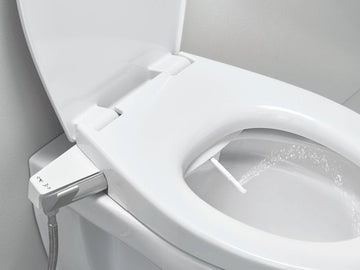In recent years, the eco friendly benefits of bidets have captured the attention of environmental enthusiasts and practical homeowners alike. With the growing concerns over climate change and sustainability, more people are seeking ways to reduce their carbon footprint while enhancing their daily lives. Bidets, a bathroom fixture often associated with luxury, have emerged as an essential tool in promoting an eco-friendly lifestyle. Let's delve into the myriad advantages of incorporating bidets into your daily routine, with a particular focus on their environmental impact.

Understanding the Eco-Friendly Nature of Bidets
To truly appreciate the eco friendly benefits of bidets, it's crucial to understand how they function. Unlike traditional toilets that rely heavily on toilet paper, bidets use a stream of water to clean, significantly reducing the need for paper products. This simple yet effective method not only offers a cleaner and more hygienic experience but also contributes to environmental sustainability.
According to DripX, the use of bidets can save millions of trees annually. Since toilet paper production is a major cause of deforestation, incorporating bidets in homes can play a pivotal role in preserving our forests and reducing carbon emissions.
Reducing Toilet Paper Waste
One of the most significant benefits of using bidets is the drastic reduction in toilet paper consumption. The average person uses about 57 sheets of toilet paper per day, which accumulates to a staggering 20,805 sheets annually. By using a bidet, individuals can cut their toilet paper usage by up to 75%. This reduction not only saves trees but also decreases the amount of waste produced in landfills.
Furthermore, the production and transportation of toilet paper contribute to greenhouse gas emissions. By decreasing our dependence on toilet paper, we can reduce these emissions and take a step towards a more sustainable future. For more on how bidets can aid in waste reduction, visit Are Bidets Sanitary?.
Conserving Water with Bidets
While it may seem counterintuitive, bidets can actually help conserve water. The process of manufacturing a single roll of toilet paper requires approximately 37 gallons of water. In contrast, bidets use only about one-eighth of a gallon per use. This significant difference highlights the water-saving potential of bidets, making them an environmentally friendly alternative to traditional toilets.
Moreover, the reduced need for toilet paper means less water is used in its production. By choosing bidets, homeowners can actively participate in water conservation efforts, which is especially crucial in areas facing water scarcity. To understand more about the water conservation aspect, check out How to Use a Bidet.
The Hygienic Edge
Beyond their environmental benefits, bidets offer a superior level of hygiene compared to traditional toilet paper. The gentle stream of water ensures a thorough clean, reducing the risk of infections and irritations. This hygienic advantage is particularly beneficial for individuals with sensitive skin or certain medical conditions.
Additionally, the reduced reliance on toilet paper helps prevent plumbing issues, such as clogs and sewage backups, which can have environmental repercussions. A cleaner bathroom experience coupled with fewer plumbing problems makes bidets a smart choice for the environmentally conscious consumer.
Cost-Effective and Sustainable
While the initial investment in a bidet may seem daunting, the long-term savings are substantial. The reduction in toilet paper consumption translates to significant cost savings over time. In fact, many homeowners find that their bidets pay for themselves within a year or two.
Moreover, the durability and low maintenance requirements of modern bidets ensure they remain a sustainable choice for years to come. For more insights into the economic advantages of bidets, consider exploring this guide.
Embracing a Greener Tomorrow
The transition to eco-friendly bathroom habits is a small yet impactful step towards a more sustainable future. By choosing bidets, individuals can enjoy a cleaner, more hygienic experience while actively contributing to environmental conservation efforts. The eco friendly benefits of bidets extend beyond personal hygiene, offering a tangible solution to pressing environmental challenges.
As we strive to reduce our ecological footprint, embracing sustainable technologies like bidets can pave the way for a greener tomorrow. To learn more about the history and evolution of bidets, visit History of Bidets.

FAQs
Are bidets really eco-friendly?
Yes, bidets are considered eco-friendly due to their ability to significantly reduce toilet paper consumption and conserve water compared to traditional toilet use.
How much water can I save by using a bidet?
Bidets use about one-eighth of a gallon of water per use, whereas producing a single roll of toilet paper requires approximately 37 gallons of water. This makes bidets a water-saving alternative.
Are bidets hygienic?
Absolutely. Bidets provide a superior level of cleanliness by using a gentle stream of water, which is more effective than toilet paper in removing bacteria and reducing the risk of infections.
This article contains affiliate links. We may earn a commission at no extra cost to you.






